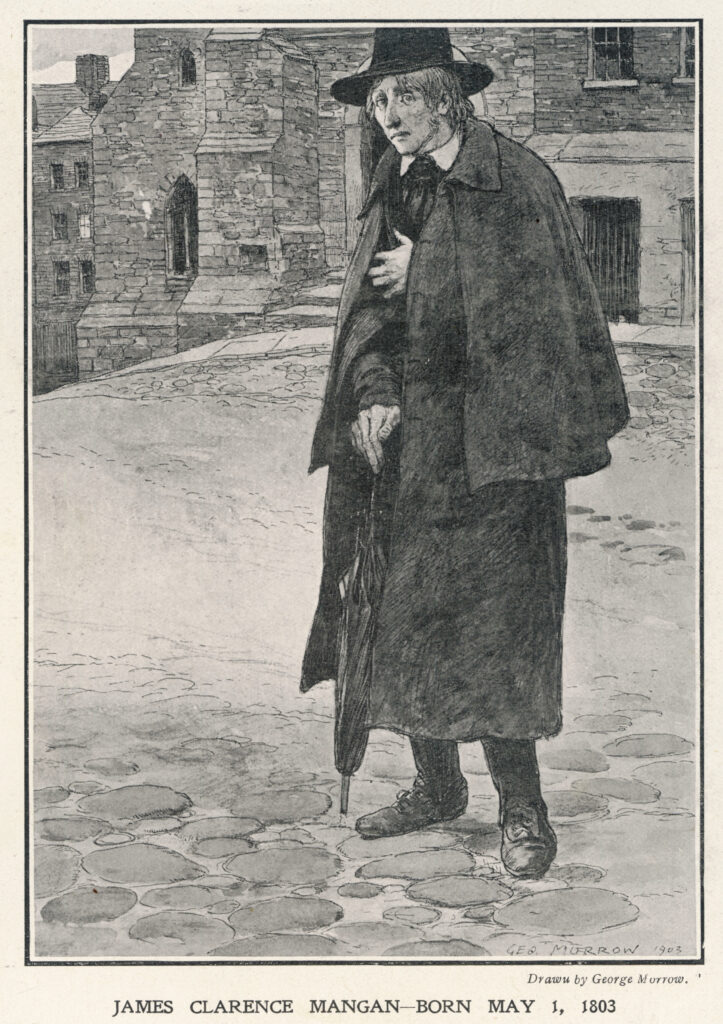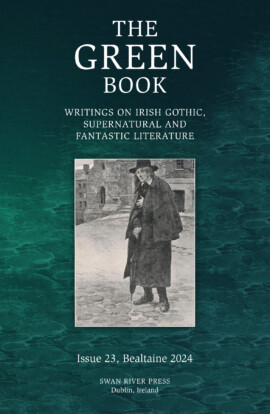Contents
“Editor’s Note” – Brian J. Showers
“A Sketch of Charles Maturin” – James Clarence Mangan
“A Sketch of John Anster” – James Clarence Mangan
“A Sketch of Maria Edgeworth” – James Clarence Mangan
“Questioning Attributions of Stories Supposedly by Fitz-James O’Brien” – Douglas A. Anderson
“Stories of Genius and Madness: Fitz-James O’Brien’s Laboratories of the Mind” – John P. Irish
“An Interview with Mrs. Riddell” – Helen C. Black
“A Note on Keith Fleming” – Richard Bleiler
“As Long as War Remaineth” – Keith Fleming
“Hidden Æons: Searching for a Literary Relic” – Brian J. Showers
“In Conversation on Irish Writers and Ireland” – Mervyn Wall
“Harry Price: The Biography of a Ghost Hunter” – Mervyn Wall
“The Castletown Witch” – Mervyn Wall
“Notes on Contributors”
 Editor’s Note #23
Editor’s Note #23
As a whole, I like to think that The Green Book serves as a sort of portrait of Irish Gothic literature in its myriad guises, incomplete though it may be, but ever adding detail to the canvas. Looking over this issue, I feel that most of what has been assembled here are portraits of the proprietors of the darker fantastic—some of the pieces are direct reminiscences, others illustrate their subjects in more oblique ways. I like when this happens—when the themes of an issue, or even just an approach, emerge of their own accord.
The opening triptych of portraits in this issue comes courtesy of the thunder-scarred poet James Clarence Mangan (1803-1849), whose beckoning and forlorn visage also adorns this issue’s cover. Those of you who pay attention to such things, take note that 30 October will be the 200th anniversary of Charles Maturin’s death (1782-1824). Mangan’s reminiscence of the author of Melmoth the Wanderer (1820) makes for a colourful portrayal; it strikes me now as I read it that this piece is the touchstone for how we now perceive Maturin, with all his eccentricities and swiftly underappreciated Gothic legacy. Maturin’s final resting place seems to be something of a mystery. I won’t speculate here, but if any reader wishes to conduct an investigation—and write up their findings for The Green Book—please do.
Mangan also writes on his contemporary, John Anster (1793-1862), who is best remembered today for his English translation of Goethe’s Faust, later used in the 1925 edition illustrated by Harry Clarke. In his third sketch, Mangan gives us a brief critical overview of the oeuvre of Maria Edgeworth (1768-1849), though oddly does not mention Castle Rackrent (1800). This omission is a fascinating one and a reminder that the work of an author which we today hold in the highest regard, might not be the book for which they were celebrated during their lifetime or at the time of their death—after all, when was the last time you read Bram Stoker’s Reminiscences of Sir Henry Irving, much lauded in the weeks following 20 April 1912?
A brief side note, albeit a morbid one: Mangan penned an addendum noting that Edgeworth died during the composition of his sketch. Edgeworth died on 22 May 1849; the sketch was published on the 26th of the same month; Mangan himself scarcely survived another month, dying on 20 June 1849. Edgeworth was buried in the churchyard at St. John’s in Edgeworthstown; Mangan rests in Glasnevin Cemetery on the northside of Dublin.
There is much else to explore in this issue, each article illuminating in different ways its subject. Helen C. Black gives us a bucolic interview with Charlotte Riddell—wonderfully capturing the latter’s personality; while John P. Irish and Douglas A. Anderson each explore aspects of Fitz-James O’Brien’s writing: the former examines a pair of O’Brien’s most popular tales through the lens of mad science, while the latter reconsiders a clutch of stories in the light of recent bibliographic scholarship.
An unfinished canvas comes to us from Richard Bleiler, who has unearthed more biographical information (and a previously unpublished poem) by the enigmatic “Keith Fleming”—Kathleen Fitz-Patrick (1849-1945)—author of Can Such Things Be? (1889) and By the Night Express (1889). There’s an exploration of George William Russell’s mystical transformation into “A.E.”; and finally a trio of pieces by Mervyn Wall, including his dazzling reminiscences of mid-century Dublin’s literary milieu, and his encounter with Gerald Gardner at the Museum of Witchcraft while on holiday in the Isle of Man.
On a final note, I would like to dedicate this issue of The Green Book to the memory of David J. Skal, a writer, scholar and friend who was no stranger to these pages. You might have your own favourites, but of his books, these are mine: The Monster Show, Dark Carnival, Death Makes a Holiday, and Something in the Blood. You can find David’s scholarship in The Green Book issues two, four, and six, the latter of which contains a lengthy interview with him. Thank you for the inspiration, David. Rest easy—and keep doing the Monster Mash wherever you are!
Brian J. Showers
Æon House, Dublin
16 January 2024
Brian J. Showers
Brian J. Showers is originally from Madison, Wisconsin. He has written short stories, articles, and reviews for magazines such as Rue Morgue, Ghosts & Scholars, and Supernatural Tales. His short story collection, The Bleeding Horse, won the Children of the Night Award in 2008. He is also the author of Literary Walking Tours of Gothic Dublin (2006), the co-editor of Reflections in a Glass Darkly: Essays on J. Sheridan Le Fanu (2011), and the editor of The Green Book. Showers also edited four volumes of Uncertainties anthology series, and co-edited with Jim Rockhill, the Ghost Story Award-winning anthology Dreams of Shadow and Smoke. He lives in Dublin, Ireland.
Read more
The Green Book 23 (Bealtaine 2024) edited by Brian J. Showers. Cover art: “James Clarance Mangan” by George Morrow (1903); cover design by Meggan Kehrli; editor’s note by Brian J. Showers; edited by Brian J. Showers; copyedited by Jim Rockhill; typeset by Steve J. Shaw; published by Swan River Press at Æon House.
Paperback: Published on 26 April 2024; limited to 250 copies; 108 pages; digitally printed on 80 gsm paper; ISSN: 2009-6089.
 About The Green Book
About The Green Book
Aimed at a general readership and published twice-yearly, The Green Book is Swan River Press’s house journal that features commentaries, articles, and reviews on Irish Gothic, Supernatural and Fantastic literature.
Certainly favourites such as Bram Stoker and John Connolly will come to mind, but hopefully The Green Book also will serve as a pathway to Ireland’s other notable fantasists: like Fitz-James O’Brien, Charlotte Riddell, Lafcadio Hearn, William Allingham, J. Sheridan Le Fanu, Cheiro, Harry Clarke, Dorothy Macardle, Lord Dunsany, Elizabeth Bowen, C. S. Lewis, Mervyn Wall, Conor McPherson . . . and this list is by no means exhaustive.
It should be noted that the word “Irish” in the journal’s title should be understood as inclusive rather than exclusive. The Green Book will also feature essays on Irish themes—even if by non-Irish authors. We hope that you will find something of interest here, for there is much to explore.
The Green Book is open for submissions.
Praise for The Green Book
“A welcome addition to the realm of accessible nonfiction about supernatural horror.” – Ellen Datlow
“Serious aficionados of the weird should also consider subscribing to The Green Book.” – Michael Dirda
“An exceptionally well-produced periodical.” – S. T. Joshi
“[A] wonderful exploration of a weird little corner of literature, and a great example of how careful editing can make even the most obscure subject fascinating and entertaining beyond all expectations.” – The Agony Column
“Eminently readable . . . [an] engaging little journal that treads the path between accessibility and academic depth with real panache.” – Black Static
“The overall feel here is not of fusty excavation in a small corner of the literary world, but of exploration on a broad front that continues to unearth intriguing finds.” – Supernatural Tales


 Editor’s Note #23
Editor’s Note #23
 About The Green Book
About The Green Book